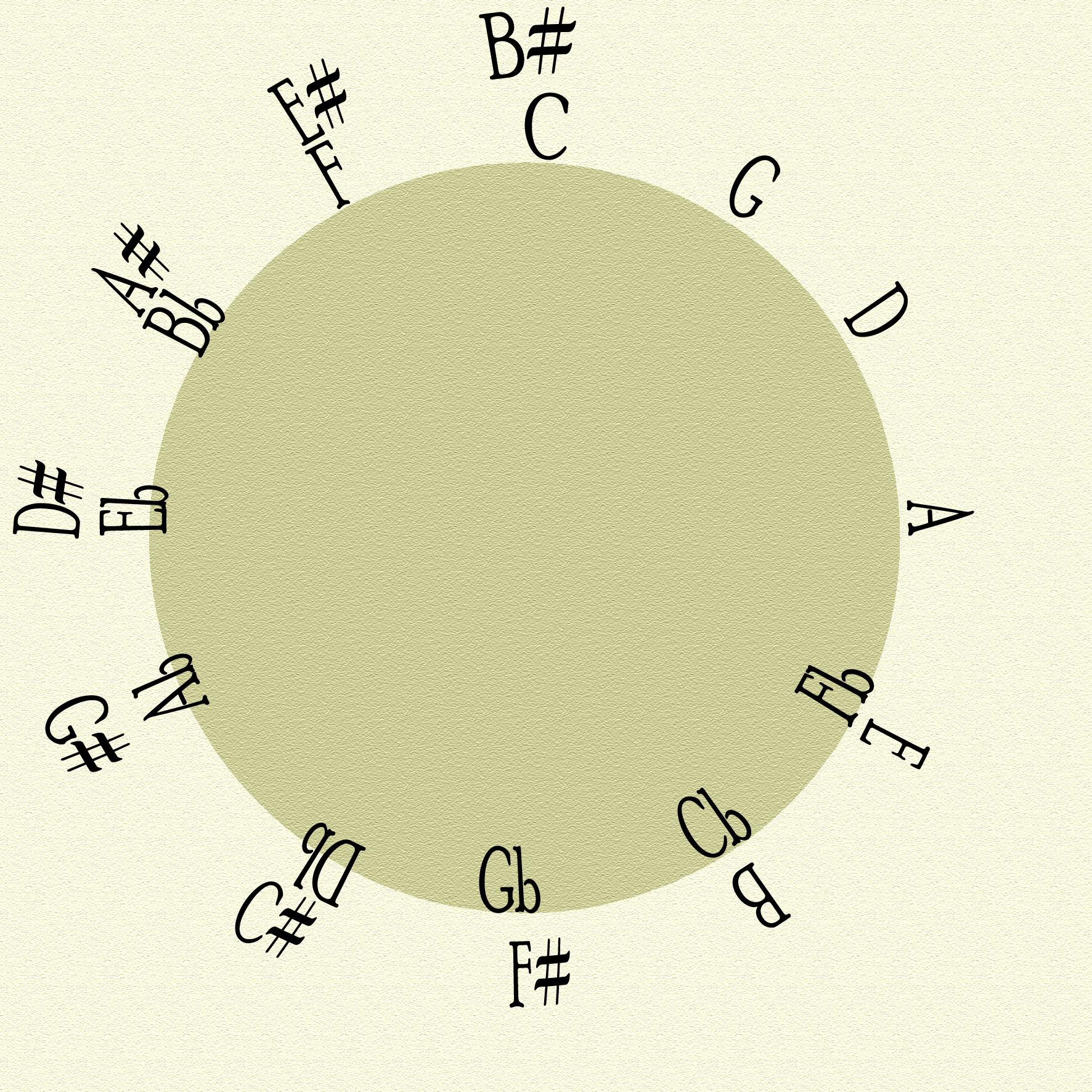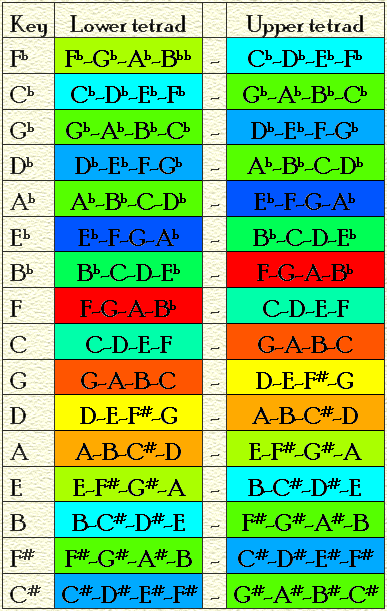When reading sheet music, and identifying the accidentals in a particular scale through key signatures.
The key signatures they add to the clef at the beginning of the measure doesn't necessarily line up with the notes that are in the scale on the clef nor are they in the same order of the notes on the clef, why is that?
If you measure each key signature on the clef, they do represent the same note but not on the same line if you get where I'm coming from?
OK, so the issue is one of why and how the flats and sharps relate to the individual keys.
Need to think outside the box for a moment and it becomes clear:
A key signature is about the alteration of every note within a scale so that each major scale will fit the pattern TTSTTTS
The Key signatures are also related to each by another small factor, as we move from all notes flat to all notes sharp, we are raising one note in each current scale to get the next scale
To illustrate further, here is a rip from another tutorial I posted earlier, with additions and emmendations/corrections
Circle of fifths because you
circle around it.
It is the relationship of key signatures as you move through them, pure and simple.
In all there are 21 key signatures. This is because each note can be named as flat ([sup]b[/sup]), natural or sharp ([sup]#[/sup])
A[sup]b[/sup]-B[sup]b[/sup]-C[sup]b[/sup]-D[sup]b[/sup]-E[sup]b[/sup]-F[sup]b[/sup]-G[sup]b[/sup]
A-B-C-D-E-F-G
A[sup]#[/sup]-B[sup]#[/sup]-C[sup]#[/sup]-D[sup]#[/sup]-E[sup]#[/sup]-F[sup]#[/sup]-G[sup]#[/sup]
If we were to arrange these key names in sequence from F[sup]b[/sup] to B[sup]#[/sup], like so:
F[sup]b[/sup]-C[sup]b[/sup]-G[sup]b[/sup]-D[sup]b[/sup]-A[sup]b[/sup]-E[sup]b[/sup]-B[sup]b[/sup]-F-C-G-D-A-E-B-F[sup]#[/sup]-C[sup]#[/sup]-G[sup]#[/sup]-D[sup]#[/sup]-A[sup]#[/sup]-E[sup]#[/sup]-B[sup]#[/sup]
where each key is a fifth above the previous one, we can see how we can begin to call this a circle of fifths.
We can conceivably bend both ends of this sequence to create a circle that wraps around itself:
But notice that the two ends are not lined up. In fact, they wrap, spiral like, around to reach the start again at B[sup]#[/sup].
Generally we only use 14 of keys C[sup]b[/sup]-C[sup]#[/sup] from the above, as the rest are overkill (you end up with 12[sup]#[/sup]'s for B[sup]#[/sup]).
Upper and lower tetrachords
When we construct major scales we start from the concept that there is a fixed pattern of notes applied to every possible starting note:
T(one)-T-S(emitone)-T-T-T-S.
Let's break that down a bit, because it looks like there might be some symmetry inside of that:
T-T-S
T
T-T-S
Consider the C Major scale
CDEF
GABC
The distance between C and D is the same as between G-A; between A and B is the same as between D and E; the distance between E and F the same as the distance between B and C. Each of these four note scale fragments, called tetrachords (literally 4 notes from the Greek tetra - four), has the same pattern: TTS. In any major scale we separate the lower and upper tetrachords by a tone, hence our original pattern
TTSTTTS.
Now let's go back to the original circle of fifths. Filling in each of the scales, we can see the upper and lower tetrachord pattern being continually updated as we move from F[sup]b[/sup] to C[sup]#[/sup]. Looking more closely, we see that each new key after F[sup]b[/sup] uses the upper tetrachord of the preceeding key as the lower tetrachord of the new key, i.e. each scale is prefaced in the upper tetrachord of the scale before it in the Circle of 5ths. This is a partial explanation of why there is such a strong link between the dominant (the key a 5th above) and sub-dominant (the key a 5th below) to the main key.
The table is colour-coded to show where the same tetrachords (regardless of actual note name) occur.
Looking closely at the table we can also see the following two features
- When we move up from F[sup]b[/sup]-C[sup]#[/sup] the seventh note in each successive scale is sharpened or raised a semi-tone
- When we move down from C[sup]#[/sup]-F[sup]b[/sup] the fourth note of each successive scale is flattened or lowered by a semitone.
The first is the accepted hallmark of the [sup]#[/sup] key signatures/scales.
The second is the accepted hallmark of the [sup]b[/sup] key signatures/scales.
Now to the signatures themselves (the bit that must be bothering you), leaving out the extremes of double flats and double sharps.......
| Key | Signature note Order | Scale |
| Cb | B[sup]b[/sup]-E[sup]b[/sup]-A[sup]b[/sup]-D[sup]b[/sup]-G[sup]b[/sup]-C[sup]b[/sup]-F[sup]b[/sup] | C[sup]b[/sup]-D[sup]b[/sup]-E[sup]b[/sup]-F[sup]b[/sup]-G[sup]b[/sup]-A[sup]b[/sup]-B[sup]b[/sup]-C[sup]b[/sup] |
| Gb | B[sup]b[/sup]-E[sup]b[/sup]-A[sup]b[/sup]-D[sup]b[/sup]-G[sup]b[/sup]-C[sup]b[/sup] | G[sup]b[/sup]-A[sup]b[/sup]-B[sup]b[/sup]-C[sup]b[/sup]-D[sup]b[/sup]-E[sup]b[/sup]-F-G[sup]b[/sup] |
| Db | B[sup]b[/sup]-E[sup]b[/sup]-A[sup]b[/sup]-D[sup]b[/sup]-G[sup]b[/sup] | D[sup]b[/sup]-E[sup]b[/sup]-F-G[sup]b[/sup]-A[sup]b[/sup]-B[sup]b[/sup]-C-D[sup]b[/sup] |
| Ab | B[sup]b[/sup]-E[sup]b[/sup]-A[sup]b[/sup]-D[sup]b[/sup] | A[sup]b[/sup]-B[sup]b[/sup]-C-D[sup]b[/sup]-E[sup]b[/sup]-F-G-A[sup]b[/sup] |
| Eb | B[sup]b[/sup]-E[sup]b[/sup]-A[sup]b[/sup] | E[sup]b[/sup]-F-G-A[sup]b[/sup]-B[sup]b[/sup]-C-D-E[sup]b[/sup] |
| Bb | B[sup]b[/sup]-E[sup]b[/sup] | B[sup]b[/sup]-C-D-E[sup]b[/sup]-F-G-A-B[sup]b[/sup] |
| F | B[sup]b[/sup] | F-G-A-B[sup]b[/sup]-C-D-E-F |
| C | | C-D-E-F-G-A-B-C |
| G | F[sup]#[/sup] | G-A-B-C-D-E-F[sup]#[/sup]-G |
| D | F[sup]#[/sup]-C[sup]#[/sup] | D-E-F[sup]#[/sup]-G-A-B-C[sup]#[/sup]-D |
| A | F[sup]#[/sup]-C[sup]#[/sup]-G[sup]#[/sup] | A-B-C[sup]#[/sup]-D-E-F[sup]#[/sup]-G[sup]#[/sup]-A |
| E | F[sup]#[/sup]-C[sup]#[/sup]-G[sup]#[/sup]-D[sup]#[/sup] | E-F[sup]#[/sup]G[sup]#[/sup]-A-B-C[sup]#[/sup]-D[sup]#[/sup]-E |
| B | F[sup]#[/sup]-C[sup]#[/sup]-G[sup]#[/sup]-D[sup]#[/sup]-A[sup]#[/sup] | B-C[sup]#[/sup]-D[sup]#[/sup]-E-F[sup]#[/sup]-G[sup]#[/sup]-A[sup]#[/sup]-B |
| F[sup]#[/sup] | F[sup]#[/sup]-C[sup]#[/sup]-G[sup]#[/sup]-D[sup]#[/sup]-A[sup]#[/sup]-E[sup]#[/sup] | F[sup]#[/sup]-G[sup]#[/sup]-A[sup]#[/sup]-B-C[sup]#[/sup]-D[sup]#[/sup]-E[sup]#[/sup]-F[sup]#[/sup] |
| C[sup]#[/sup] | F[sup]#[/sup]-C[sup]#[/sup]-G[sup]#[/sup]-D[sup]#[/sup]-A[sup]#[/sup]-E[sup]#[/sup]-B[sup]#[/sup] | C[sup]#[/sup]-D[sup]#[/sup]-E[sup]#[/sup]-F[sup]#[/sup]-G[sup]#[/sup]-A[sup]#[/sup]-B[sup]#[/sup]-C[sup]#[/sup] |
sup]-G[sup]b[/sup]-A[sup]b[/sup]-B[sup]bb[/sup]-C[sup]b[/sup]-D[sup]b[/sup]-E[sup]b[/sup]-F[sup]b[/sup][/td][/tr]
The sharps and flats appear in the particular order given to show the sequence of keys - as you add more sharps the keys go clockwise around the circle; as you add more flats the keys go counter-clockwise around the circle......
An old friend and many websites suggest the following two phrases to remember the sequence of sharps and flats in key signatures:
Flats: Battle Ends And Down Goes Charles Father
Sharps: Father Charles Goes Down And Ends Battle
| Key | Signature note Order | Phrase |
| Cb | B[sup]b[/sup]-E[sup]b[/sup]-A[sup]b[/sup]-D[sup]b[/sup]-G[sup]b[/sup]-C[sup]b[/sup]-F[sup]b[/sup] | Battle Ends And Down Goes Charles Father |
| Gb | B[sup]b[/sup]-E[sup]b[/sup]-A[sup]b[/sup]-D[sup]b[/sup]-G[sup]b[/sup]-C[sup]b[/sup] | Battle Ends And Down Goes Charles |
| Db | B[sup]b[/sup]-E[sup]b[/sup]-A[sup]b[/sup]-D[sup]b[/sup]-G[sup]b[/sup] | Battle Ends And Down Goes |
| Ab | B[sup]b[/sup]-E[sup]b[/sup]-A[sup]b[/sup]-D[sup]b[/sup] | Battle Ends And Down |
| Eb | B[sup]b[/sup]-E[sup]b[/sup]-A[sup]b[/sup] | Battle Ends And |
| Bb | B[sup]b[/sup]-E[sup]b[/sup] | Battle Ends |
| F | B[sup]b[/sup] | Battle |
| C | | |
| G | F[sup]#[/sup] | Father |
| D | F[sup]#[/sup]-C[sup]#[/sup] | Father Charles |
| A | F[sup]#[/sup]-C[sup]#[/sup]-G[sup]#[/sup] | Father Charles Goes |
| E | F[sup]#[/sup]-C[sup]#[/sup]-G[sup]#[/sup]-D[sup]#[/sup] | Father Charles Goes Down |
| B | F[sup]#[/sup]-C[sup]#[/sup]-G[sup]#[/sup]-D[sup]#[/sup]-A[sup]#[/sup] | Father Charles Goes Down And |
| F[sup]#[/sup] | F[sup]#[/sup]-C[sup]#[/sup]-G[sup]#[/sup]-D[sup]#[/sup]-A[sup]#[/sup]-E[sup]#[/sup] | Father Charles Goes Down And Ends |
| C[sup]#[/sup] | F[sup]#[/sup]-C[sup]#[/sup]-G[sup]#[/sup]-D[sup]#[/sup]-A[sup]#[/sup]-E[sup]#[/sup]-B[sup]#[/sup] | Father Charles Goes Down And Ends Battle |
Language use
T(one) = Whole-step
S(emitone) = Half-step
Cycle vs circle
The circle is also mistakenly called the cycle. this is because they are both focused on the relationship of each pair of notes/keys being a 5th apart.
The
circle of 5ths is about the tetrachord relationship between subsequent keys.
The
cycle of 5ths is about the relationship between chords within a key and by extension, the borrowed and exotic chords that can be played within a particular key.
As for which side the sharp and flat keys should go on, it makes no difference. Traditionally it has been set up so that we move clockwise from flat keys to sharp keys - the important thing is that we recognise a movement of a fifth when we do move clockwise through the circle. We could just as easily put C at the bottom, defying all tradition.....


